Overview
This article serves as a comprehensive guide on how renting tools and machinery can significantly enhance efficiency and reduce costs in project management. By renting, you gain access to the latest technology, enjoy flexibility in equipment selection, and eliminate maintenance responsibilities. These factors collectively contribute to improved productivity and cost savings, making renting an attractive option for a variety of projects.
In addition to these benefits, renting allows for a tailored approach to your project needs. Whether you require heavy machinery or specialized tools, the rental market offers a diverse selection that can adapt to the specific demands of your projects. This flexibility not only streamlines operations but also ensures that you are equipped with the right tools for the job, further driving efficiency.
Furthermore, the reliability of rented equipment is paramount. Many rental companies provide well-maintained, high-quality tools that meet industry standards. Customer testimonials often highlight the positive experiences of those who have utilized rental services, emphasizing the peace of mind that comes with knowing you are using dependable equipment.
To sum up, renting tools and machinery is not just a practical choice; it is a strategic decision that can lead to substantial benefits in project management. Don't hesitate to explore your options and discover how renting can transform your approach to projects. Take action today and unlock the potential of equipment rental for your next project.
Key Highlights:
- Renting tools and machinery offers significant cost savings, reducing ownership costs by 30-50%.
- Access to the latest technology enhances productivity on job sites.
- Flexibility in renting allows for tailored equipment selection without long-term commitments.
- Maintenance and repairs are typically handled by rental companies, leading to further savings.
- Renting eliminates the need for storage space, optimising operational areas.
- Effective management of rented tools includes conducting pre-operation checks and adhering to operating instructions.
- Training team members on equipment use is crucial for safety and efficiency, reducing the risk of accidents.
- Evaluating rental experiences helps optimise future equipment rentals by analysing performance and costs.
Introduction
Renting tools and machinery has emerged as a strategic approach for businesses looking to enhance efficiency while managing costs. By opting for rentals, companies can access the latest technology without the burden of significant upfront investments, unlocking substantial savings and flexibility. However, the question remains: how can organizations ensure they maximize the benefits of rented equipment while avoiding common pitfalls?
This guide delves into the essential steps for effectively renting tools, from assessing project needs to optimizing future rentals. Empower your business to boost productivity and streamline operations by understanding the advantages of equipment rentals.
Understand the Benefits of Renting Tools and Machinery
The benefits of renting tools and machinery include increasing efficiency with rented tools and machinery while also significantly reducing overall expenses. Among these advantages are:
- Cost Savings: Renting removes the considerable upfront costs associated with purchasing equipment. Instead, you incur only a fraction of the cost for the duration of your project, facilitating better budget management. Companies can save approximately 30-50% of total ownership costs by choosing rentals, making this approach increasingly attractive in today's economic landscape.
- Access to Latest Technology: Rental companies consistently provide the latest models and advanced technology, ensuring you have access to the most efficient and effective tools available. This access can substantially boost productivity on job sites, particularly by increasing efficiency with rented tools and machinery.
- Flexibility: Renting allows you to select equipment tailored to specific requirements without the long-term commitment of ownership. This flexibility proves particularly advantageous for short-term projects or fluctuating workloads.
- Reduced Maintenance Costs: Maintenance and repairs are generally handled by rental companies, freeing you from the responsibility of upkeep and unexpected repair expenses, which can lead to significant savings.
- Storage Solutions: Renting negates the need for storage space, as you retain the tools only for the duration of your assignment, thus optimizing your operational area.
- Enhanced Efficiency and Safety: Forklifts, vital components of construction equipment, are essential for lifting heavy materials and transporting equipment on job sites. By renting forklifts from EZ Equipment Rental, which offers a variety of models suited to diverse job requirements, you can achieve increasing efficiency with rented tools and machinery, greatly enhancing both efficiency and safety on your work site while ensuring proper material management and minimizing the risk of accidents.
Understanding these benefits empowers informed decision-making that aligns with your goals and budget constraints.
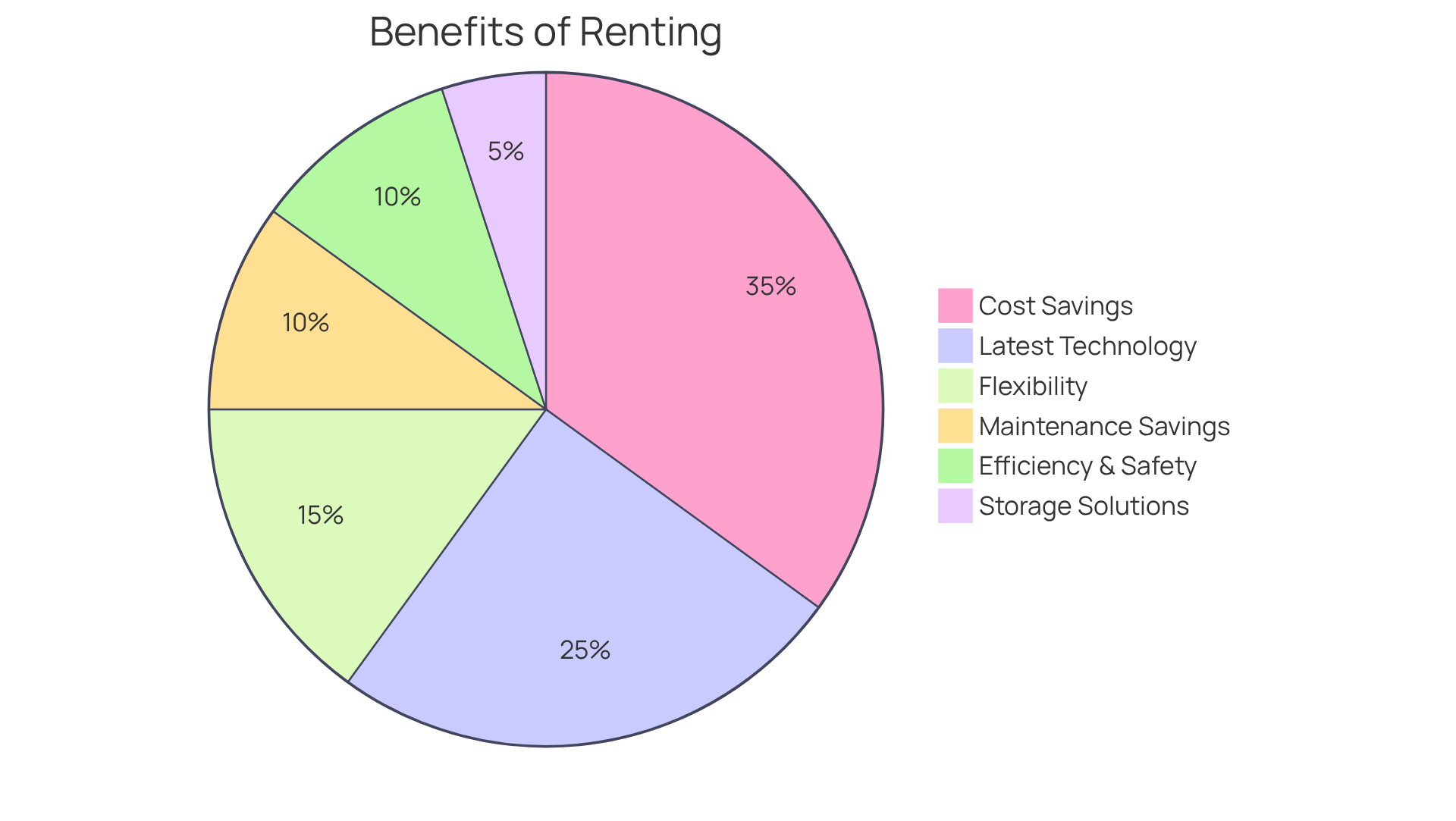
Assess Project Needs and Budget for Equipment Rental
To efficiently rent tools in the DFW Metroplex, it is crucial to evaluate your requirements and establish a budget. Begin by defining your project scope: clearly outline the tasks that need to be completed, considering the size, duration, and specific requirements of your endeavor. Next, identify the necessary tools; based on your task scope, enumerate the types of tools required. For instance, if you are engaged in a landscaping project, you may need equipment such as boom lifts, excavators, or forklifts.
Researching leasing expenses is vital. Examine the hiring prices for the tools you require, noting that these can vary depending on the category of tools, lease length, and regional market conditions, particularly in Irving, TX. Daily hire charges can range from $100 to over $3,500, contingent on the equipment. Establishing a budget is your next step; determine how much you can allocate for gear rental, including potential additional costs such as delivery fees, insurance, and maintenance. It is prudent to set aside a reserve for unforeseen expenses, as operational inefficiencies may arise due to the cyclical nature of construction activities.
Consulting with stakeholders is also essential. If applicable, discuss your resource needs and budget with team members or stakeholders to ensure alignment and gather additional insights. By thoroughly evaluating your requirements and allocating funds appropriately, you can make informed choices that enhance your experience with EZ Equipment Rental. This approach ensures you have the right tools for the task, maximizing both productivity and financial efficiency.
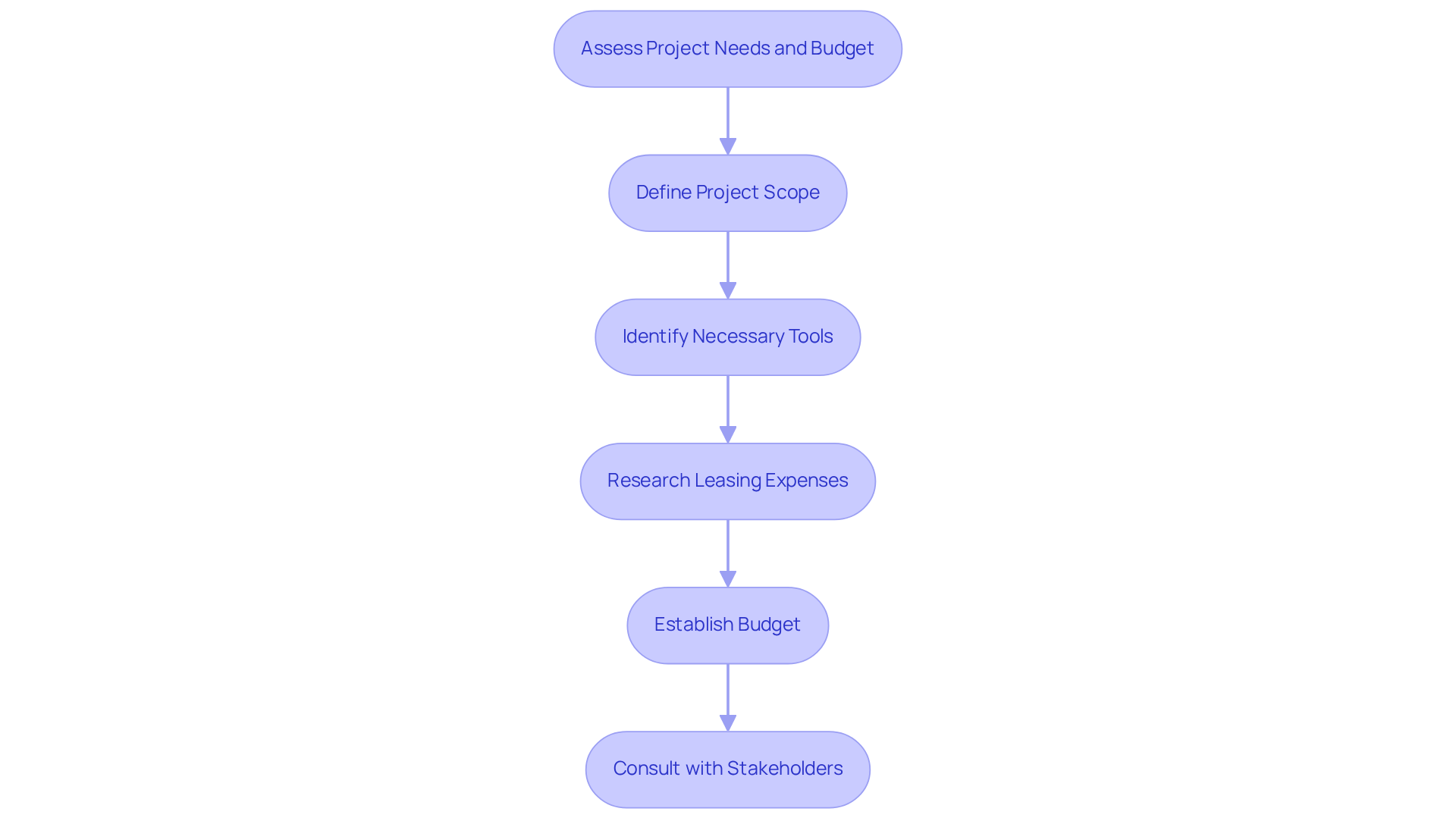
Select a Reliable Equipment Rental Company
Selecting the appropriate equipment leasing service is crucial for the success of your endeavor. To make an informed decision, follow this structured approach:
- Research Alternatives: Begin by compiling a list of nearby leasing services known for their solid industry reputation. A highly regarded firm can significantly enhance your project's efficiency by increasing efficiency with rented tools and machinery.
- Check Reviews and References: Customer reviews provide invaluable insights. They reveal perspectives on the dependability and service excellence of leasing businesses. Seek consistent positive feedback and request references to validate these claims.
- Assess Gear Quality: Visit the leasing company to inspect the gear personally. Ensure that it is well-maintained, meets safety standards, and aligns with your specific needs. Using high-quality equipment plays a crucial role in increasing efficiency with rented tools and machinery, which helps prevent delays and boost productivity.
- Inquire About Lease Terms: Familiarize yourself with the lease agreement, including pricing, duration, and any additional fees. Transparency is essential; ensure there are no hidden costs that could impact your budget.
- Evaluate Customer Service: The responsiveness and supportiveness of the service's staff can greatly influence your experience. An organization that prioritizes customer service is likely to provide superior assistance throughout the leasing process.
- Check Accessibility: Confirm that the organization has the necessary tools available for your desired leasing duration. Availability can be a critical factor in meeting project timelines.
By adhering to these steps, you can select a trustworthy rental firm that meets your needs, which is essential for increasing efficiency with rented tools and machinery.
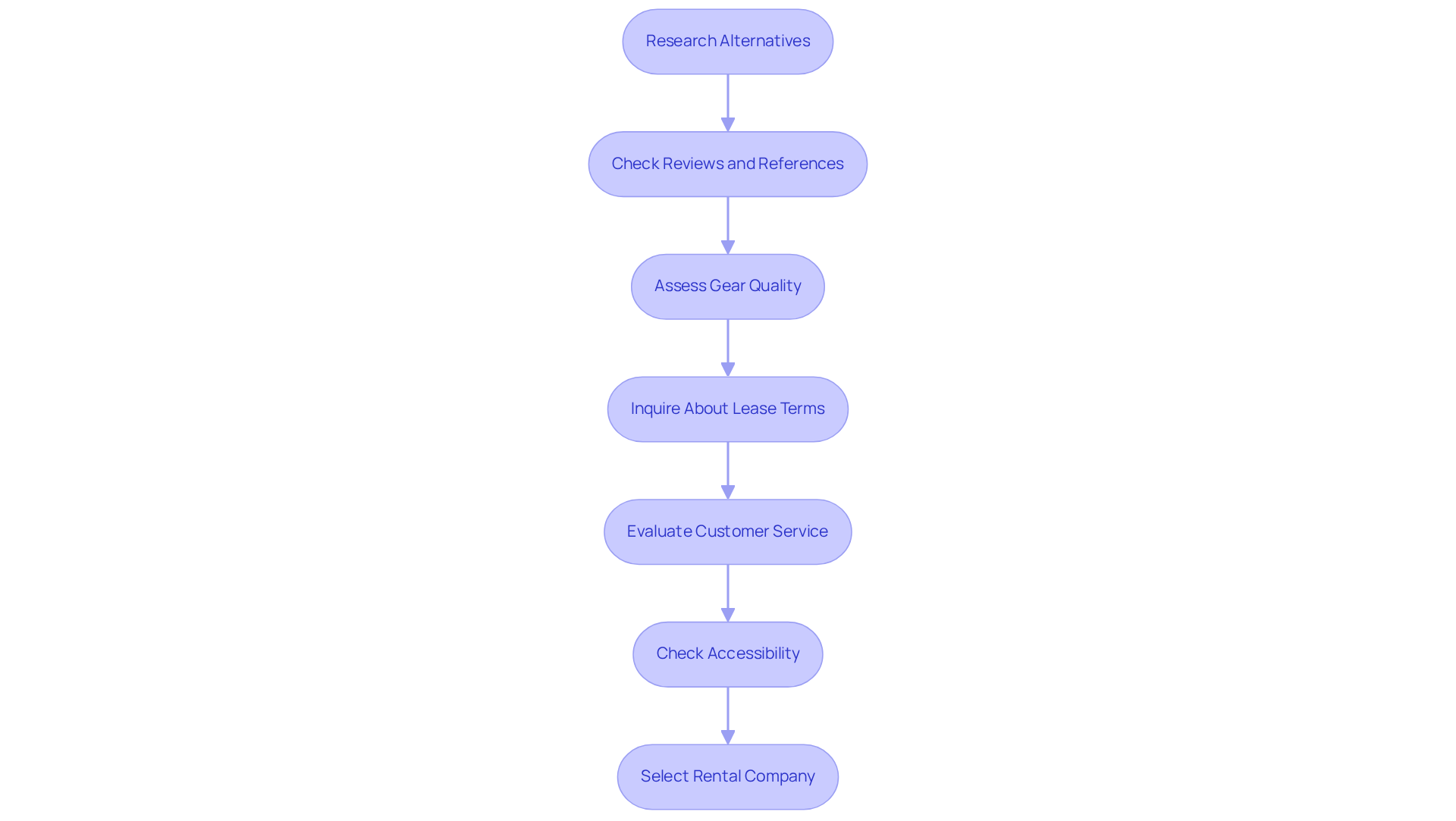
Manage Equipment Efficiently During the Rental Period
Effective management of leased tools is crucial for increasing efficiency with rented tools and machinery in the seamless execution of any project. Implementing key strategies can significantly enhance productivity and safety.
-
Conduct Pre-Operation Checks: Before utilizing any rented tools, it is vital to conduct a thorough inspection to ensure they are in optimal working condition. Look for visible damage, maintenance issues, or any signs of wear that could affect performance. Studies indicate that organizations that implement routine safety checks experience a marked decrease in incidents. Additionally, understanding load limits is crucial for ensuring safe lifting practices—never leave this to chance.
-
Follow Operating Instructions: Adhering strictly to the manufacturer’s operating guidelines guarantees not only the safe utilization of the equipment but also enhances its efficiency, thereby decreasing the likelihood of incidents. The CDC reports that 60% of crane-related fatalities stem from rigging failures, underscoring the critical importance of following these guidelines.
-
Train Your Team: Proper training for all team members who will use the machinery is indispensable. Statistics indicate that well-trained operators significantly reduce the risk of accidents and machinery damage. In fact, the average cost of a workplace injury can reach up to $43,000, while the indirect costs of forklift accidents can be four to six times the direct costs, potentially exceeding $200,000. This clearly highlights the financial benefits of investing in training.
-
Monitor Usage: Maintain comprehensive logs of equipment usage, including frequency and intensity. This proactive approach helps identify potential issues early, allowing for timely interventions that can prevent costly downtime.
-
Schedule Regular Maintenance: If permitted by your lease agreement, arrange for regular maintenance checks. This practice not only keeps the equipment in optimal condition but also prolongs its lifespan, ensuring reliability throughout the usage period.
-
Communicate with the Rental Company: Maintain open lines of communication with the rental company. Prompt reporting of any issues can facilitate quick resolutions and minimize disruptions to your work.
By applying these strategies, you can achieve increasing efficiency with rented tools and machinery, resulting in better outcomes and lower operational expenses. Additionally, referencing case studies, such as those focusing on ladder safety, can provide real-world examples that reinforce the importance of these safety practices.
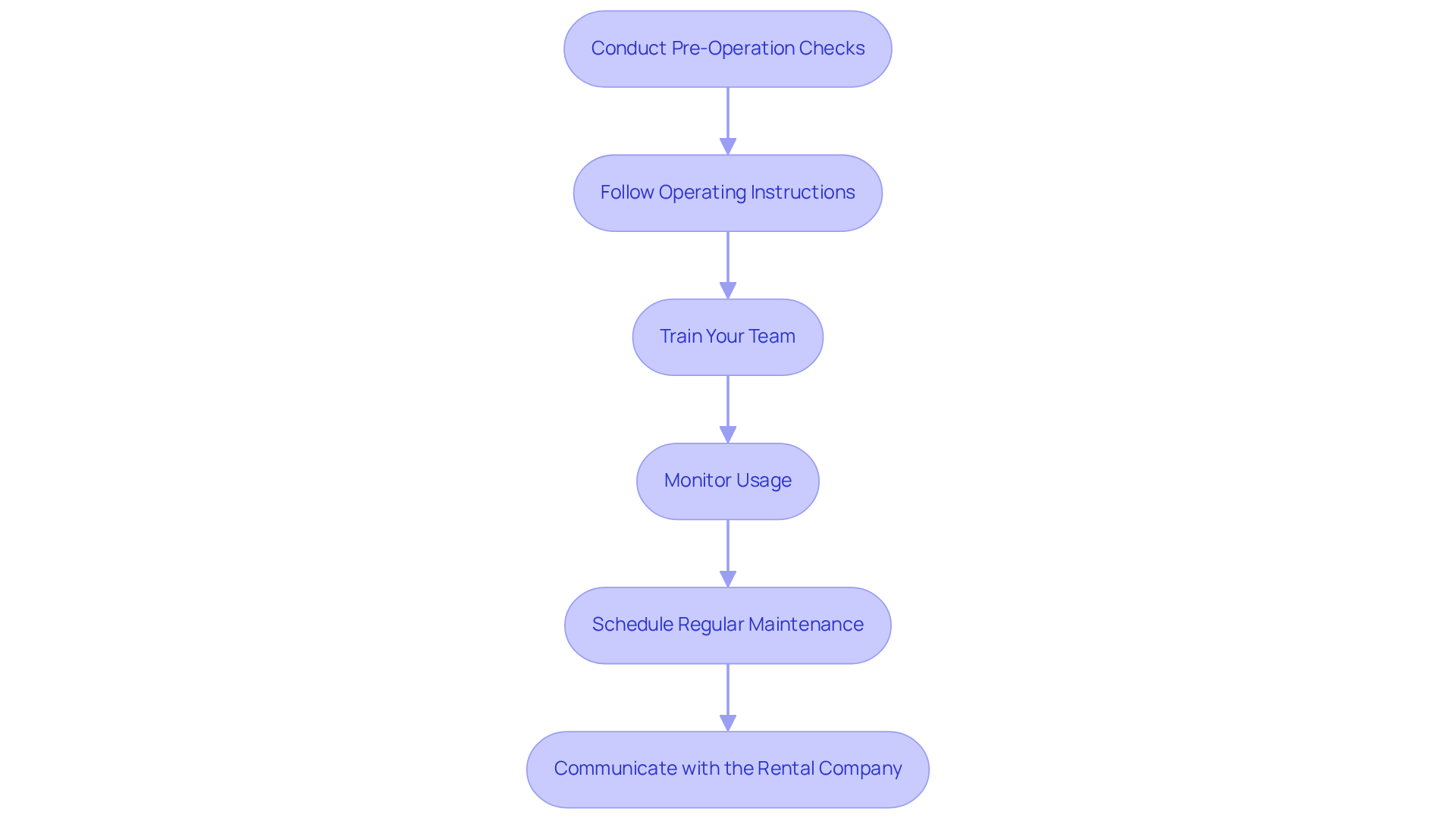
Evaluate and Optimize Future Equipment Rentals
After completing your assignment, take the opportunity to evaluate your experience with the borrowed gear. This assessment is crucial for optimizing future rentals:
- Review Performance: Evaluate how effectively the rented tools performed during your project. Did they meet your expectations? Were there any challenges?
- Analyze Costs: Compare the leasing expenses to your budget. Were there any unexpected costs? Understanding these can enhance your budgeting accuracy moving forward.
- Gather Feedback: Solicit input from your team regarding the usability and performance of the tools. This feedback can provide invaluable insights for future leases.
- Identify Improvements: Based on your assessment, pinpoint areas for enhancement. This may involve selecting different tools, adjusting lease durations, or considering alternative providers.
- Document Lessons Learned: Maintain a record of what succeeded and what fell short. This documentation will serve as a reference for future initiatives.
By thoroughly evaluating and refining your equipment rental process, you can achieve increasing efficiency with rented tools and machinery in your upcoming projects.
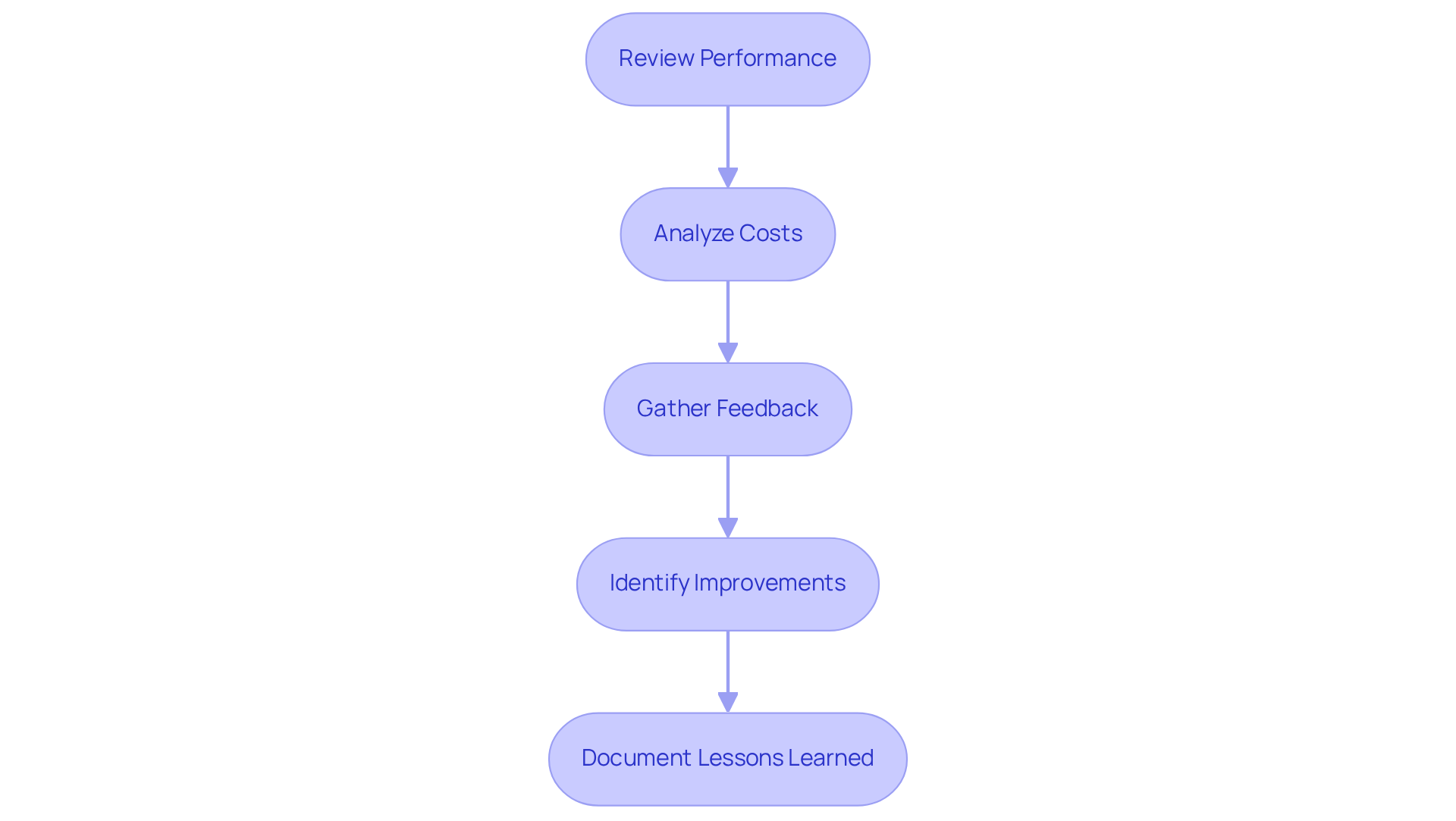
Conclusion
Renting tools and machinery stands out as a strategic choice for maximizing efficiency and minimizing costs across various projects. By choosing rentals, individuals and companies can reap substantial savings, gain access to state-of-the-art technology, and enjoy the flexibility needed to meet specific project demands without the burdens of ownership. This approach not only boosts operational efficiency but also alleviates the financial pressures associated with purchasing and maintaining equipment.
The article underscores several key arguments that advocate for the benefits of renting tools:
- Cost savings that can soar up to 50%
- The significance of selecting a reputable rental company
- Effective management strategies throughout the rental period
Each of these points emphasizes the importance of meticulous planning and informed decision-making to ensure that the rental experience aligns seamlessly with project objectives and budgetary constraints. The insights provided serve as a practical guide for anyone aiming to harness rented tools to enhance productivity and optimize project outcomes.
Ultimately, embracing the practice of renting tools and machinery can yield transformative benefits for projects of all sizes. As the demand for efficiency and cost-effectiveness continues to escalate, adopting a rental strategy not only addresses immediate project needs but also positions individuals and businesses for sustained success. By proactively assessing requirements, choosing reliable providers, and managing equipment adeptly, stakeholders can unlock the full potential of rented tools, paving the way for heightened productivity and reduced operational costs in future endeavors.
Frequently Asked Questions
What are the benefits of renting tools and machinery?
The benefits of renting tools and machinery include cost savings, access to the latest technology, flexibility, reduced maintenance costs, storage solutions, and enhanced efficiency and safety.
How do rentals help with cost savings?
Renting tools and machinery eliminates the significant upfront costs of purchasing equipment, allowing you to pay only a fraction of the total cost for the duration of your project. Companies can save approximately 30-50% of total ownership costs by opting for rentals.
What advantage does renting provide in terms of technology?
Rental companies offer the latest models and advanced technology, ensuring access to efficient and effective tools that can significantly boost productivity on job sites.
Why is flexibility an important benefit of renting?
Renting allows you to select equipment tailored to specific project requirements without the long-term commitment of ownership, which is particularly beneficial for short-term projects or varying workloads.
How do rental companies handle maintenance costs?
Maintenance and repairs are typically managed by rental companies, relieving you of the responsibility for upkeep and unexpected repair expenses, leading to substantial savings.
What storage benefits come with renting equipment?
Renting eliminates the need for storage space since you only keep the tools for the duration of your assignment, optimizing your operational area.
How does renting enhance efficiency and safety at job sites?
Renting equipment like forklifts can significantly improve efficiency and safety on job sites by ensuring proper material management and minimizing the risk of accidents.
What steps should I take to assess project needs and budget for equipment rental?
Begin by defining your project scope, identifying the necessary tools, researching leasing expenses, establishing a budget, and consulting with stakeholders to ensure alignment and gather insights.
How can I determine the costs associated with renting tools?
Examine hiring prices for the required tools, which can vary based on the type of equipment, lease length, and regional market conditions. Daily hire charges can range from $100 to over $3,500.
Why is it important to set aside a reserve for unforeseen expenses?
Setting aside a reserve for unforeseen expenses is prudent due to potential operational inefficiencies that may arise from the cyclical nature of construction activities.




